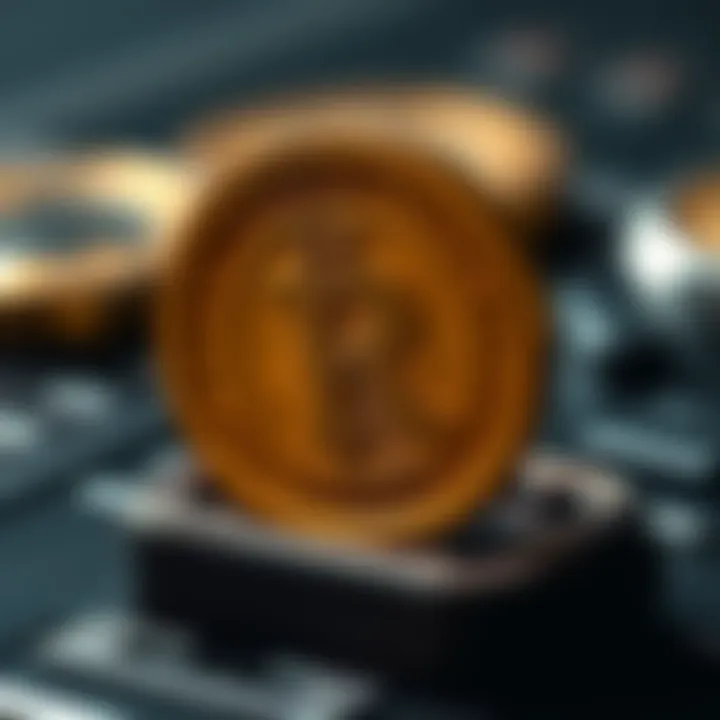Comprehensive Guide to Onyx Coin Wallet Features and Security


Intro
Cryptocurrencies have taken the financial world by storm, revolutionizing how transactions are conducted and assets are managed. At the heart of this emerging landscape is the Onyx Coin Wallet, a vital tool for anyone looking to navigate the complexities of digital currencies. This article aims to demystify the Onyx Coin Wallet, highlighting its functionalities, advantages, and how users can employ it effectively to safeguard their virtual assets. In addition, we will delve into essential concepts that underpin cryptocurrency and provide insights into current market trends.
Cryptocurrency Fundamentals
To fully appreciate the Onyx Coin Wallet, one must first grasp the basic principles governing cryptocurrencies.
Understanding Blockchain Technology
Blockchain technology is the bedrock on which all cryptocurrencies are built. In simple terms, it's a distributed ledger that records transactions across numerous computers. This decentralization means that no single entity has control over the whole system, making it nearly impossible to alter the data retroactively. Each block in the chain holds a collection of transaction data, and once a block is filled, it is cryptographically linked to the previous block.
Blockchain technology is more than just a buzzword; it's the foundation of trust in the cryptocurrency realm.
Key Concepts in Cryptocurrency Trading
Before diving into the specifics of the Onyx Coin Wallet, understanding some core concepts can be beneficial.
- Wallets: Digital wallets store private keys needed to access one’s cryptocurrency holdings. They can be software-based, like the Onyx Coin Wallet, or hardware-based.
- Tokens vs. Coins: While both represent digital assets, coins typically operate on their own blockchain (like Bitcoin), whereas tokens are built on existing blockchains (like Ethereum).
- Market Capitalization: This is the total value of a cryptocurrency and is calculated by multiplying its current price by the total supply of coins in circulation. It can provide insights into the popularity and stability of a digital asset.
With a firm grasp of these fundamentals, the stage is set to explore the specifics of the Onyx Coin Wallet and the various ways it serves its users.
Understanding Onyx Coin Wallet
Understanding the Onyx Coin Wallet is crucial for anyone stepping into the world of cryptocurrency management. In this segment, we’ll demystify what the wallet is all about, touching on its design and functions, which serve as the backbone for effective cryptocurrency transactions. The wallet is more than a simple storage solution; it’s a versatile tool designed to streamline interactions with various digital currencies. By getting to grips with its features and intended use, users can better navigate the often-choppy waters of crypto trading while ensuring their investments are secure.
Definition and Purpose
At its core, the Onyx Coin Wallet serves as a digital vault. It provides not only a safe haven for your cryptocurrencies but also facilitates the buying, selling, and exchanging of these digital assets. Think of it as your go-to bank for virtual money. What makes it stand out is its multifunctional capability, allowing users to conduct transactions across various currencies without the hassle of maintaining multiple wallets. The purpose is straightforward: to simplify how you manage your cryptocurrencies, making the whole process smoother for both novices and seasoned investors.
Overview of Features
The Onyx Coin Wallet comes packed with an array of features that enhance user experience and make management of digital currencies far easier. Here’s a closer look at some of the standout aspects that make this wallet a strategic choice for many users.
Multi-Currency Support
A significant aspect of the Onyx Coin Wallet is its multi-currency support. This feature enables users to hold multiple cryptocurrencies within a single interface. It’s like owning a Swiss Army knife for your digital assets; versatile and practical. Users can manage Bitcoin, Ethereum, Litecoin, and several other coins without juggling various wallets. The broad support for currencies not only makes it a popular choice but also opens doors for traders to diversify their portfolios efficiently. On the other hand, one downside might be that some users may find the interface somewhat crowded with numerous options, but for those who prefer versatility, this feature is a game changer.
User-Friendly Interface
When it comes to navigating the complexities of cryptocurrency, a user-friendly interface cannot be overstated. The Onyx Coin Wallet prides itself on its intuitive design, which allows users to easily access their funds, conduct transactions, and monitor their portfolio with minimal fuss. First-time users can jump right in without feeling overwhelmed, thanks to its straightforward layout. However, while the simplicity is a strong point, advanced users might want a bit more customization to cater to their specific needs. Still, overall, this trait significantly contributes to the wallet's appeal.
Integrated Exchange Options
Integrated exchange options are another feather in the cap for Onyx Coin Wallet. With these built-in features, users can exchange currencies directly within the wallet, eliminating the need to hop over to a separate platform. This not only saves time but also adds a layer of convenience. As someone who values efficiency, this aspect stands out. However, it’s worth noting that while this is undoubtedly a beneficial feature, users should remain aware of potential exchange fees that may apply during these transactions. Keeping an eye on these details can ensure that the experience remains smooth and cost-effective.
"Understanding Onyx Coin Wallet isn’t just about grasping its features but recognizing how they fit into your broader investment strategy."
In summation, the Onyx Coin Wallet is crafted to cater to a wide range of cryptocurrency needs, packaging convenience, security, and user-friendly design into one platform. Whether you’re a casual user or a serious trader, understanding these features will prepare you to make informed decisions in the ever-evolving landscape of digital currency.
Types of Wallets
In the evolving landscape of cryptocurrency management, the types of wallets available play a critical role in how users can secure and access their digital assets. Understanding the distinctions between these various wallets isn’t merely a matter of preference; it could very well dictate the security and convenience of one’s cryptocurrency holdings. This section will delve into the two primary categories of wallets: hot wallets and cold wallets, along with hardware and software wallets.
Hot Wallets vs Cold Wallets
When discussing cryptocurrency wallets, the terms "hot" and "cold" are tossed around quite a bit. But what do they really mean?
Hot wallets are online wallets, always connected to the internet. This makes them incredibly convenient for active traders since users can instantly send or receive funds. Think of it as carrying cash in your pocket—you can easily make transactions whenever the need arises. However, this constant connection to the internet also exposes hot wallets to potential security threats. Hackers love them for this very reason.
To put that into a relative perspective:


- Pros:
- Cons:
- Immediate access to funds.
- User-friendly interfaces, ideal for trading.
- Multi-currency support is typically built-in.
- Vulnerable to hacking and phishing attacks.
- Less secure than cold wallets.
On the other side of the fence, cold wallets are not connected to the internet, making them much harder to hack. They can either be hardware devices or paper wallets, providing a layer of security that is suitable for long-term storage. People who are not planning to pick up and trade often may benefit from the peace of mind that comes with cold storage. But convenience comes at a cost.
Consider the following:
- Pros:
- Cons:
- Higher level of security from online threats.
- Ideal for long-term storage of assets.
- Less convenient for immediate transactions.
- Requires extra steps to access funds, such as connecting to the internet.
Ultimately, choosing between hot and cold wallets boils down to an individual’s trading habits and risk tolerance. Some seasoned traders might opt for a hybrid approach, keeping a small portion of their assets in a hot wallet while stashing the bulk in a cold wallet for safekeeping.
Hardware and Software Wallets
The distinction between hardware and software wallets further illustrates the multifaceted nature of wallet options available to users today.
Hardware wallets are physical devices that safely store cryptocurrency offline. Think of them like a vault where you can lock away your valuables. Many well-known brands like Ledger and Trezor offer reputable hardware wallets that support various cryptocurrencies.
- Key Features of Hardware Wallets:
- Secure from malware and hacks due to offline storage.
- Typically have built-in PIN codes for added protection.
- Designed to facilitate easy recovery in case of loss.
In contrast, software wallets can be either desktop or mobile applications. These wallets provide a balance of usability and security but are more exposed to online threats compared to hardware wallets. Examples include Exodus and MyEtherWallet.
- Key Features of Software Wallets:
- Flexible and easy to use.
- Quick access to your funds.
- Often feature integrated exchange options, allowing for simple trades within the wallet.
In summary, understanding the types of wallets available—from hot and cold to hardware and software—provides the baseline for effectively managing cryptocurrency assets. Choosing the right type of wallet should align with one’s trading habits, investment goals, and desired security level.
Setting Up Your Onyx Coin Wallet
Setting up your Onyx Coin Wallet is a critical step in your cryptocurrency journey. This process lays the foundation for managing your digital assets safely and efficiently. Given the growing interest in cryptocurrencies, understanding how to set up a wallet is paramount. Preparing your wallet correctly not only enhances security but also streamlines your trading experience.
Downloading the Wallet
To kick things off, the first action is to download the Onyx Coin Wallet. Visit the official Onyx website. The integrity of your wallet starts with sourcing from a reliable source. You will usually find options for different devices—be it Android, iOS, or desktop computers—so pick the one that matches your needs.
After selecting your desired version, hit that download button, and let the process get underway. It's wise to double-check the size and version of the file; this ensures you’ve got the latest updates and security patches. Upon successful download, proceed with the installation steps, which typically involve clicking through prompts that ask for permissions, ensuring that your device allows the app to function as intended.
Creating an Account
Once the wallet is downloaded, creating an account is your next move. Open the wallet app and look for an option that says "Create New Account." It’s pretty straightforward, just like signing up for any online service. You may be required to input some basic information: your email, and sometimes you’ll need to create a strong password—something like "Secure123!" might look good, but ensure it isn’t something easy to guess.
Consider this: A strong password is the first line of defense against unwanted access. Using a mix of upper and lower case letters, numbers, and special characters is highly encouraged. Once you’ve filled in the necessary information, confirm your account through an email link usually sent by Onyx. Be aware of your email's security too; a compromised email can put your wallet at risk.
Backing Up Your Wallet
Now that your account is created, the next step is arguably the most vital: backing up your wallet. Think of this as creating a safety net. You want to ensure that if anything happens—like losing your device or a technical glitch—you can access your funds without breaking a sweat. During the backup process, the wallet will typically generate a recovery phrase, often called a mnemonic seed, which you’ll need to write down.
Important Tip: Keep this phrase in a hard-to-reach yet safe place. If you write it on paper, don’t stash it in a drawer where the kids might find it; consider a safe or a safety deposit box instead. You will like to be the only one armed with this essential information.
Failing to back up properly can lead to irreversible consequences; losing access to funds should not be taken lightly. Review those backup instructions carefully, and if possible, check for any additional options like cloud backups that Onyx may offer to make the process easier.
Setting up your Onyx Coin Wallet covers these essential facets: downloading, account creation, and backup. Each step is a piece of a larger puzzle that lays the groundwork for a secure cryptocurrency journey.
Depositing and Withdrawing Funds


Understanding the processes of depositing and withdrawing funds is paramount for users of the Onyx Coin Wallet. This section will break down the mechanics involved in smoothly adding and extracting cryptocurrency from your wallet, emphasizing the importance of security, user awareness, and strategic planning in these transactions.
When one looks at the importance of deposits and withdrawals, it becomes clear that these activities are the lifeblood of any digital wallet experience. Without the ability to move funds effortlessly, users could find themselves stranded in the marketplace, unable to capitalize on timely investment opportunities. Furthermore, it's not just about flow; it’s about security protocols to ensure that money doesn’t vanish into thin air.
How to Deposit
Depositing funds into your Onyx Coin Wallet is a straightforward process, but it demands careful attention to detail. Here’s how you can go about it:
- Select Your Currency: Start by choosing which cryptocurrency you want to deposit. Onyx Coin Wallet supports multiple currencies, such as Bitcoin, Ethereum, and others.
- Generate a Deposit Address: Navigate to the wallet’s deposit section, where you’ll see an option to generate a unique deposit address. This address is essential as it identifies your wallet on the blockchain.
- Transfer Funds: Use your existing wallet or exchange account to initiate a transfer. Enter the deposit address you've just generated, ensuring that it's accurate. Even a minor error can mean the difference between receiving funds and losing them.
- Confirm the Transaction: After initiating the transfer, check your Onyx Coin Wallet for confirmation. This typically involves waiting for several blockchain confirmations, which can take anywhere from a few minutes to a couple of hours, depending on network congestion.
It's wise to start with a small test deposit if you're new to the wallet to ensure everything functions smoothly.
Withdrawal Processes
Withdrawing funds from your Onyx Coin Wallet is equally critical, and it’s helpful to follow a structured approach:
- Initiate the Withdrawal: Access the withdrawal section of your wallet. Here is where you will indicate the amount you wish to withdraw and the destination address.
- Choose the Appropriate Address: Enter the wallet address of the account where you want the funds sent. Similar to deposits, accuracy is crucial here; a wrong address can lead to irrevocable losses.
- Verify Your Identity: Onyx Coin Wallet may require you to perform various security checks, such as entering two-factor authentication codes or confirming your account details. This extra layer of security protects your funds during the transfer.
- Transaction Fees: Be prepared for transaction fees, which vary based on the type of currency and network conditions. These fees are deducted from the total amount you request for withdrawal.
- Final Confirmation: Once all details are submitted, you will receive a confirmation prompt to finalize the withdrawal. After confirming, your request enters the blockchain for processing. Just as with deposits, monitor the status of your withdrawal to ensure a smooth transaction.
"A careful approach to deposits and withdrawals ensures that your investment remains intact while navigating the volatile waters of cryptocurrency."
Security Measures
In an era where digital assets can be incredibly lucrative yet vulnerable, security measures for any cryptocurrency wallet, including Onyx Coin Wallet, cannot be overstated. The significance of these measures lies in their capacity to protect your investments from theft, hacking, and unauthorized access. Ensuring robust security is therefore essential for both peace of mind and safeguarding one's hard-earned funds.
Encryption Technologies
Encryption forms the backbone of security in the Onyx Coin Wallet. By employing advanced encryption technologies, the wallet secures sensitive information, making it thoroughly unreadable to prying eyes. Here are some key elements to understand about its encryption features:
- Data Encryption: Onyx Coin Wallet utilizes asymmetric encryption methods to secure user data. This not only protects your balance of cryptocurrencies but also secures personal details against exploitation.
- Data Transmission Security: When you send or receive cryptocurrencies, the transactions are encrypted. This means that even if a malicious actor tries to intercept your data, all they would see is a jumble of unintelligible characters.
- Strong Algorithms: The wallet employs industry-standard cryptographic algorithms, like AES (Advanced Encryption Standard), ensuring that encryption remains uncompromised.
"Staying ahead in crypto means putting security first; encryption isn't just an option, it's a must."
The application of these technologies not only provides a strong defense against hacking attempts but also instills confidence in users that their funds are consistently shielded from external threats.
Two-Factor Authentication
Two-Factor Authentication (2FA) adds an additional layer of security that complements the existing encryption protocols. By requiring a second form of verification, this measure mitigates the risk of unauthorized access. Here’s how 2FA operates within the Onyx Coin Wallet:
- Initial Verification: Whenever you log in to your wallet, after entering your username and password, you'll be prompted to enter a code sent to your registered mobile device or email. This step ensures that even if someone knows your login info, they still cannot access your account without this code.
- Time-Sensitive Codes: The codes provided are often time-limited, typically lasting for a few minutes. This ensures even greater security as the chances of interception are minimized.
- Optional Backup Methods: Users might have the option to set up additional recovery codes or methods in case they lose access to their primary device. This ensures that the wallet remains accessible without sacrificing security value.
By implementing Two-Factor Authentication, Onyx Coin Wallet significantly reduces the risk of unauthorized access, ensuring that only you can perform transactions with your assets. In the unpredictable world of cryptocurrencies, layers of security such as these are your best insurance policy against potential losses.
User Experience
User experience stands as a crucial pillar in the realm of digital wallets, particularly with Onyx Coin Wallet. It encompasses how users interact with the wallet, guiding them through the complexities of cryptocurrency management. A seamless user experience can distinguish top-tier wallets from the rest, ultimately affecting users' satisfaction and their willingness to return. This section dives into significant elements that shape user experiences, offering insights into the interface design and customer support within the Onyx ecosystem.
Interface Design
The interface design of Onyx Coin Wallet is not just about aesthetics; it plays a pivotal role in usability. A well-designed interface caters to both seasoned investors and newcomers, welcoming them into the cryptocurrency world without overwhelming them. Key aspects of the interface include:
- Clarity and Simplicity: Navigation should feel intuitive. Users shouldn't need a roadmap just to make basic transactions. Onyx prioritizes clear labeling and straightforward menus
- Responsive Layout: Since many operate wallets on mobile devices, Onyx ensures that the platform is responsive, adapting to various screen sizes and orientations while maintaining usability.
- Visual Feedback: Action confirmations need to be immediate. When users deposit or transfer coins, they should receive instant feedback. Onyx implements visual cues to signify successful transactions, which reduces anxiety during trading.
- Customization Options: Allowing users to adjust settings, such as notification preferences and security options, can enhance their sense of control.
Taking these points into account, Onyx’s interface emerges as a user-friendly tool designed to smooth the learning curve for newcomers while offering efficiency for veterans.
Customer Support
In the world of cryptocurrency, where the stakes can be high, having reliable customer support is undeniably vital. Onyx Coin Wallet recognizes this and has structured its support system to provide timely assistance. The significance of customer support includes:
- Accessibility: A user shouldn’t have to navigate a labyrinth just to find help. Onyx provides multiple avenues for support, including email, FAQs, and live chat, ensuring users can access help when they need it most.
- Response Time: The quicker the response, the better the experience. Onyx is committed to reducing resolution times, as long wait periods can lead to user frustration.
- Knowledge Base: A comprehensive FAQ section serves as the first line of defense for common inquiries. This empowers users with information they might need before reaching out for help.
- Community Engagement: Beyond direct support, Onyx participates in online forums, such as Reddit, positioning itself as a relatable presence in the community. This connection aids in building trust and understanding user needs.
To sum it up, the user experience surrounding Onyx Coin Wallet reflects a deep understanding of user needs and expectations. From its intuitive interface design to robust customer support, Onyx positions itself as a wallet that effectively addresses both the novice ind fear of the digital currency realm and the experienced trader's quest for efficiency.
Addressing Challenges


Navigating the world of cryptocurrency is like walking through a minefield. Many investors, traders, and tech enthusiasts often run into common hurdles when managing their Onyx Coin Wallets. Understanding these challenges isn’t just helpful, it’s essential for anyone looking to engage with digital currencies confidently. Various considerations play into this realm—from security hiccups to user experience flaws, the importance of recognizing and addressing these issues can’t be overstated.
For starters, being aware of common issues means one can avoid potential pitfalls. Whether you are a newcomer to the cryptocurrency scene or a seasoned trader, recognizing possible shortcomings with the Onyx Coin Wallet can save valuable time and resources down the line. As the saying goes, "forewarned is forearmed." Several specific elements can contribute to the challenges faced by users.
Here’s why addressing these challenges matters:
- User Adoption: A smoother experience leads to better user engagement. When people know how to troubleshoot problems, they’re likelier to continue using Onyx Coin Wallet.
- Market Education: Users who can navigate difficulties learn more about the cryptocurrency space, becoming informed participants rather than passive bystanders.
- Security Risks: Awareness of potential threats assists users in fortifying their wallet against hacks or breaches.
- Feedback Loop: By understanding common issues, developers can improve the wallet, creating a positive feedback system that benefits everyone.
"Every problem is a gift—without problems, we would not grow."
This sentiment rings true in the context of addressing challenges related to using Onyx Coin Wallet.
Common Issues and Troubleshooting
With great technology, come great expectations—and sometimes, disappointments. Familiarizing yourself with the typical issues may make your experience far less frustrating. Here are some frequently encountered problems:
- Wallet Access Issues: Sometimes users may find themselves locked out due to incorrect password entry or other authentication problems. The best practice includes double-checking keyboard inputs for accidental caps.
- Transaction Delays: Users may experience unexpected lags in transactions processing. It can be a result of network congestion or setting too low a fee.
- Missing Transactions: Occasionally, users report transactions that don’t show up in their balance immediately. It’s essential to check the transaction status on the blockchain explorer and understand that it may take time to confirm.
To troubleshoot effectively, follow these steps:
- Always double-check your credentials.
- Consult the official Onyx Coin Wallet support forums or FAQs for immediate solutions.
- Regularly back up your wallet to avoid severe losses if the worst happens.
User Feedback and Improvement
The conversation around the Onyx Coin Wallet continues to grow, especially with community feedback shaping its evolution. Users are integral in pointing out weaknesses and suggesting enhancements.
Many users have expressed how critical it is for the platform to listen and adapt. Here’s how user feedback plays a role:
- Feature Requests: Many users ask for additional features like advanced charts for investment tracking or better integration with exchanges.
- Usability Improvements: Users frequently point out complicated steps in the wallet setup process, urging the team to streamline operations for newcomers.
- Security Concerns: Regular feedback highlights features that need more robustness, like two-factor authentication.
In closing, a proactive approach to addressing challenges presents a cycle of continuous improvement. As users share their experiences, developers have the opportunity to refine their offerings. Staying tuned into user feedback not only enhances the consumer experience but plays a significant role in building trust within the crypto landscape.
Future of Onyx Coin Wallet
The future of the Onyx Coin Wallet holds a great deal of significance for both existing and prospective users, investors, and the cryptocurrency ecosystem at large. As the digital currency landscape evolves, wallets like Onyx need to adapt to meet the changing needs and preferences of their user base. This section dives into potential upgrades and market trends that can shape the Onyx Coin Wallet going forward.
Potential Upgrades
Looking ahead, Onyx Coin Wallet could introduce several upgrades that enhance user experience, expand functionalities, and bolster security measures. Here are a few noteworthy aspects that might become pivotal:
- Enhanced User Interface: A more intuitive layout could make navigation smoother. Users today demand simplicity mixed with functionality, making it essential for the wallet's design to evolve constantly.
- Support for More Cryptocurrencies: As the number of cryptocurrencies continues to grow, integrating new currencies into the wallet could attract a wider audience. The inclusion of trending cryptocurrencies might entice traders and investors always on the lookout for new opportunities.
- Advanced Security Features: With cyber threats constantly emerging, Onyx could invest in features like biometric authentication and enhanced encryption protocols to instill confidence among users. Upgrades in security must go hand in hand with technological enhancements, ensuring users’ funds remain safe.
- Decentralized Finance (DeFi) Integration: The rise of DeFi represents a critical avenue for development. Enabling users to participate in lending, borrowing, and yield farming directly from their wallets could present new possibilities for crypto enthusiasts.
These potential upgrades not only aim to enhance usability but also address pressing concerns, creating a compelling reason for users to adopt and stay with Onyx.
Market Trends and Predictions
Observing market trends is crucial for predicting the trajectory of any digital wallet. For Onyx Coin Wallet, several patterns stand out that could define its future:
- Increased Cryptocurrency Adoption: As traditional institutions embrace digital currencies, more individuals are likely to enter the crypto space. A growing user base increases the demand for wallets like Onyx, pushing the need for improved service offerings.
- Regulatory Developments: Regulatory frameworks around cryptocurrencies continue to evolve across different countries. Compliance with these regulations is becoming a necessity for wallets. Onyx will need to monitor these developments closely, ensuring it aligns with global standards to avoid penalties and maintain user trust.
- Focus on Interoperability: The growing importance of seamless integration across various blockchain networks may prompt wallets to work harmoniously together. Onyx could benefit from partnerships with other wallets and platforms, allowing users easier access to a wider range of digital assets.
- Integration with Traditional Finance: Users are increasingly interested in the fusion of traditional finance and cryptocurrencies. Tools that allow for easy conversion between fiat and onyx may increase its appeal significantly.
"In the ever-changing landscape of cryptocurrency, adaptability is not just an advantage; it’s a necessity for survival."
In summary, the future of Onyx Coin Wallet is shaped by various factors, including technological advancements, user demands, and market trends. Staying on top of these aspects will be key for Onyx to not only remain relevant but also thrive in the competitive crypto landscape.
Culmination
The conclusion serves as the capstone of our exploration of the Onyx Coin Wallet. It reinforces the critical points highlighted throughout the article, emphasizing the wallet's pivotal role in the cryptocurrency landscape. Understanding the mechanics of the Onyx Coin Wallet isn't just for tech enthusiasts or traders; it's essential for any individual looking to navigate the often turbulent waters of digital finance.
Summary of Insights
As we wrap up, let's recap the key insights gathered:
- Multi-Currency Support: This feature sets Onyx Coin Wallet apart, allowing users to handle various cryptocurrencies within a single platform, streamlining transactions and management.
- Security Protocols: We underscored the importance of robust security measures, such as encryption technologies and two-factor authentication, safeguarding users against potential threats.
- User-Centric Design: The emphasis on a user-friendly interface simplifies the complex processes involved in cryptocurrency management, making it approachable for novices and experts alike.
- Addressing Challenges: We discussed common issues and the proactive steps users can take to troubleshoot effectively, ensuring smooth operations and user satisfaction.
These insights equip users not only to make informed decisions but also foster confidence in their transaction choices.
Final Thoughts on Onyx Coin Wallet
In summary, the Onyx Coin Wallet stands out in the increasingly crowded crypto wallet market. It's not merely a tool, but a companion for investors, traders, and casual users navigating the digital money world. Its strengths lie in its balance between security, versatility, and user experience. However, users should remain vigilant, continuously updating themselves on the latest trends and potential security threats in the cryptocurrency space. The wallet will likely evolve, introducing enhancements that may further simplify or secure transactions. Hence, it is prudent for users to stay engaged and informed to maximize their experience with the Onyx Coin Wallet.
As you step forward in your cryptocurrency journey, consider how the Onyx Coin Wallet aligns with your goals. Armed with knowledge from this comprehensive exploration, you can ensure that you are not only using a powerful tool but also understanding its full potential.



